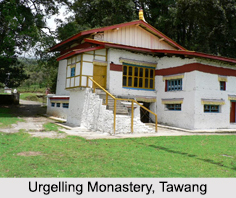 Urgelling monastery has been the celebrated birthplace of the sixth Dalai Lama, Tsangyang Gyatso. Urgelling monastery lies about 5 kilometers to the south of the Tawang town in the north eastern Indian state of Arunachal Pradesh. It is surrounded by the Himalayas and the Tawang-Chu valley. Urgelling Monastery was built in 15th century CE, 1489 by Urgen Sangpo as a Buddhist spiritual centre.
Urgelling monastery has been the celebrated birthplace of the sixth Dalai Lama, Tsangyang Gyatso. Urgelling monastery lies about 5 kilometers to the south of the Tawang town in the north eastern Indian state of Arunachal Pradesh. It is surrounded by the Himalayas and the Tawang-Chu valley. Urgelling Monastery was built in 15th century CE, 1489 by Urgen Sangpo as a Buddhist spiritual centre.
History of Urgelling Monastery
Urgelling Monastery was the first of the three monasteries, which was built by Urgen Sangpo. He was the younger brother of Terton Pempalingpa- popular treasure-revealer. Urgelling Monastery has been the residence of the Buddhist monks and Lamas following the Lamaistic Mahayana school of thought. This monastery is considered as one of the sacred monasteries particularly after the birth of the sixth Dalai Lama. Restored and enlarged, this monastery was rebuilt in 1699 by Desi Sangye Gyamtso.
Architecture of Urgelling Monastery
With the modern day architecture, the place has a double storied main temple, an assembly hall with eight pillars, an altar room with four pillars, a deity with two pillars, a residential quarter for the sixth Dalai Lama, a chapel to practice the Tantrik methods, Ka-Gyur house and a courtyard with twenty rooms that was built as the residential quarters of the monks and the Lamas.
Urgelling Monastery however stopped functioning since 1706 when the sixth Dalai Lama was deposed by Lajang Khan. The monastery was then invaded by the army of Lajang Khan. It was finally then disserted and all its possessions like scriptures, statues and other holy objects were placed in Tawang Monastery. After all the invasions, Urgelling Monastery is mainly known for providing shelter to the monks who stay in the monastery.
Festivals of Urgelling Monastery
The monastery organizes various festivals among which Losar and Torgya hold prominence. The Losar festival is celebrated in the month of January. It marks the beginning of the New Year according to the lunar calendar; the festival lasts for 15 days. And Torgya is celebrated by the Lamas of the monastery. It is celebrated for three days while starting from the 28th day of the eleventh month of the lunar calendar.
Visiting Information to Urgelling Monastery
Urgelling Monastery can be easily accessed by road, air, and rail. Arunachal State Transport operates bus service to Bomdila. Private buses also ply daily via Bomdila up to Tezpur. One can also avail Jeep services. The nearest airport is at Tezpur in Assam which is directly connected to Kolkata. The nearest railhead is at Guwahati in Assam, which is connected to the major cities like Delhi, Kolkata and Mumbai.



















